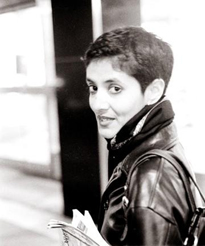
“A lot of [India’s] challenges can be measured in the lives of children,” Somini Sengupta said during her talk Freedom’s Future: Learning and Destiny in India Today on February 10.
The talk was part of the South Asian Studies Council colloquia series. Sengupta, former Delhi Bureau Chief of The New York Times, gave a moving speech on the paradox of childhood today in India, and the threat it poses to India’s future.
Growing up as a Calcutta-born immigrant in Canada in the 1970s, Sengupta remembers “having to explain to people that I was the other kind of Indian.” Her family then moved to California, where they became part of the South Asian, and specifically Bengali, population. But there weren’t many young people around Sengupta’s age, and she grew up within a culture very different from the one she had left back in Calcutta. After graduating Berkeley with an English degree, she wasn’t ready to make the plunge into graduate school and a life of academia. So she took a job with the LA Times, and found that she really enjoyed the work of a journalist. While getting on-the-job training, she was “constantly having to explain even to my editors what South Asian even meant.” When, three years later, she became a reporter for The New York Times, she continued to have to explain herself. When she mentioned Bollywood, she used to have to write a follow-up clause explaining that it was “India’s mainstream cinema.” Today, such a clause would be almost laughable. People were frequently asking her if she was reporting on the Southeast Asian community. “I had to explain that, no, it was a different part of Asia.”
Today, everything is different. “It’s exciting just to see how many people here who are not of South Asian decent, are interested in the region,” she says of the diverse scholars associated with the South Asian Studies Department here at Yale. Not only that, but media attention in general has allowed Sengupta to have an incredibly diverse target audience. She says that the media and scholarly shifts can largely be attributed to the “huge shift” that has taken place in India’s economic and political expansion over the last few decades. India has dramatically expanded its international negotiating clout, and the rest of the world has had no choice but to learn about the country and the region.
Critical developments in political and economic power have fostered a rise of education in the West on India. But it is the level of education in India that Sengupta spoke on.
Sengupta’s talk was framed in an anonymous rural Indian village, cleverly dubbed “The Future.” In The Future, every morning, children in tired clothing walk to the excuse of a building that serves as their school, empty rice sacks under arms to use as chairs, and textbooks that are written in a slew of languages and don’t teach the same material. Some have no textbooks at all. Most don’t have shoes.
Sengupta took her audience on a sobering tour of the educational crisis in India. Only two out of three teachers of the school in The Future showed up for school, and one was an hour late. Similar stories are told across India. Teaching jobs don’t pay well, and many teachers practice absenteeism and simultaneously work at different government posts, such as voter registration, which actually pay more.
“[The children] come here to learn,” Sengupta quotes an Indian university graduate volunteer at the school, “They leave learning nothing. One day they will curse us.”
India may have a democratic structure in government, but everyday life in India is far from democratic. India may be expanding as an economic and diplomatic power, but it is not supporting a large percentage of its most vulnerable, and valuable, citizens: its children. Sixty percent of forth graders in India are functionally illiterate. Those who manage to gain a decent education do so in expensive private institutions that mostly utilize the International Baccalaureate program, or through private tutoring.
There is a substantial problem within the Indian public education system, and, across India there is hunger for education. “Something [in India] has changed,” Sengupta says, “something substantial. Only a few, with names like mine, were destined to go to school.” Today, people see education as an opportunity for upward mobility. Even though the quality of education available to many Indians is virtually nonexistent, the desire for education is growing, and the void is being acknowledged within the government. The 2009 Right to Education bill requires all children under 14 to attend school.
There is yet another significant population of children whose real hunger prevents them ever experiencing hunger for education. Even though there have been no widespread famines in modern India, the level of malnutrition in children is startlingly high. Though NGOs and other aid groups do their best to feed these youngsters, a shocking 42.5% of Indian children are underweight. Anemia is high among both mothers and their children. Despite India’s recently established $1.3 billion network feed center, implementation efficacy is low. The most at-risk group, those under 2 years, has hardly been targeted at all.
Sengupta doesn’t have a solution to the problems she is pointing out. She sees it as her job to expose the problems and the facts. “The challenge that India faces,” she says, “is enormous. No country [in a democratic setting] has faced that before.”
